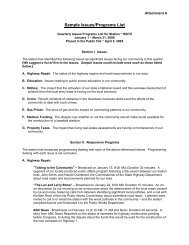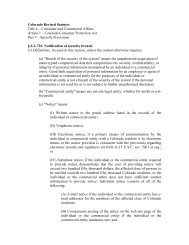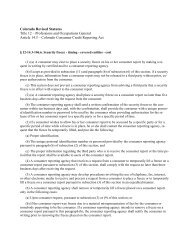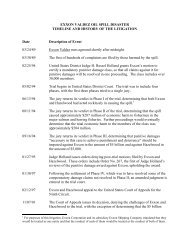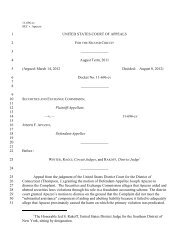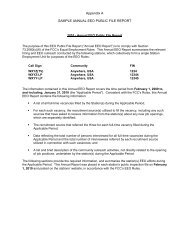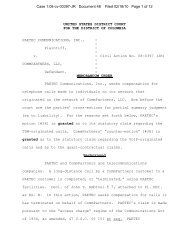QUANTA SERVICES INC, QUANTA SERVICES MANAGEMENT ...
QUANTA SERVICES INC, QUANTA SERVICES MANAGEMENT ...
QUANTA SERVICES INC, QUANTA SERVICES MANAGEMENT ...
Create successful ePaper yourself
Turn your PDF publications into a flip-book with our unique Google optimized e-Paper software.
<strong>QUANTA</strong> <strong>SERVICES</strong>, <strong>INC</strong>. AND SUBSIDIARIES<br />
NOTES TO CONSOLIDATED FINANCIAL STATEMENTS — (Continued)<br />
these considerations, management utilizes various valuation methods, including an income approach, a market<br />
approach and a cost approach, to determine the fair value of intangible assets acquired based on the<br />
appropriateness of each method in relation to the type of asset being valued. The assumptions used in these<br />
valuation methods are analyzed and compared, where possible, to available market data, such as industry-based<br />
weighted average costs of capital and discount rates, trade name royalty rates, public company valuation<br />
multiples and recent market acquisition multiples. The level of inputs used for these fair value measurements is<br />
the lowest level (Level 3). Quanta believes that these valuation methods appropriately represent the methods that<br />
would be used by other market participants in determining fair value.<br />
Quanta uses fair value measurements on a routine basis in its assessment of assets classified as goodwill,<br />
other intangible assets and long-lived assets held and used. In accordance with its annual impairment test during<br />
the quarter ended December 31, 2011, the carrying amounts of such assets, including goodwill, were compared to<br />
their fair values. The inputs used for fair value measurements for goodwill, other intangible assets and long-lived<br />
assets held and used are the lowest level (Level 3) inputs for which Quanta uses the assistance of third party<br />
specialists to develop valuation assumptions.<br />
Quanta also uses fair value measurements in connection with the valuation of its investments in private<br />
company equity interests and financing instruments. These valuations require significant management judgment<br />
due to the absence of quoted market prices, the inherent lack of liquidity and the long-term nature of such assets.<br />
Typically, the initial costs of these investments are considered to represent fair market value, as such amounts are<br />
negotiated between willing market participants. On a quarterly basis, Quanta performs an evaluation of its<br />
investments to determine if an other-than-temporary decline in the value of each investment has occurred<br />
and whether the recorded amount of each investment will be realizable. If an other-than-temporary decline in the<br />
value of an investment occurs, a fair value analysis would be performed to determine the degree to which the<br />
investment was impaired and a corresponding charge to earnings would be recorded during the period. These<br />
types of fair market value assessments are similar to other fair value measures used by Quanta, which include the<br />
use of significant judgment and available relevant market data. Such market data may include observations of the<br />
valuation of comparable companies, risk adjusted discount rates and an evaluation of the expected performance<br />
of the underlying portfolio asset, including historical and projected levels of profitability or cash flows. In<br />
addition, a variety of additional factors will be reviewed by management, including, but not limited to,<br />
contemporaneous financing and sales transactions with third parties, changes in market outlook and the thirdparty<br />
financing environment.<br />
3. NEW ACCOUNTING PRONOUNCEMENTS:<br />
Adoption of New Accounting Pronouncements<br />
During the quarter ended December 31, 2011, Quanta adopted Accounting Standards Update (ASU) 2011-<br />
09, “Compensation — Retirement Benefits — Multiemployer Plans (Subtopic 715-80): Disclosures about an<br />
Employer’s Participation in a Multiemployer Plan” (ASU 2011-09). This guidance requires employers to make<br />
various disclosures for each individually significant multiemployer plan that provides pension benefits to its<br />
employees. Generally, an employer must disclose the employer’s contributions to the plan during the period and<br />
provide a description of the nature and effect of any significant changes that affect comparability of total<br />
employer contributions from period to period. Additionally, the employer is required to provide a description of<br />
the nature of the plan benefits, a qualitative description of the extent to which the employer could be responsible<br />
for the obligations of the plan and other quantitative information, to the extent available, as of the most recent<br />
date available, to help users understand the financial information for each significant plan. An employer should<br />
also provide disclosures for total contributions made to all plans that are not individually significant and total<br />
contributions made to all plans. If certain quantitative information cannot be obtained without undue cost and<br />
92




